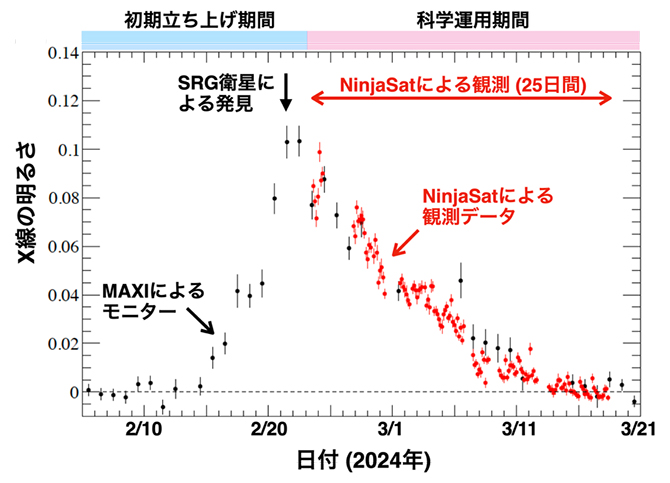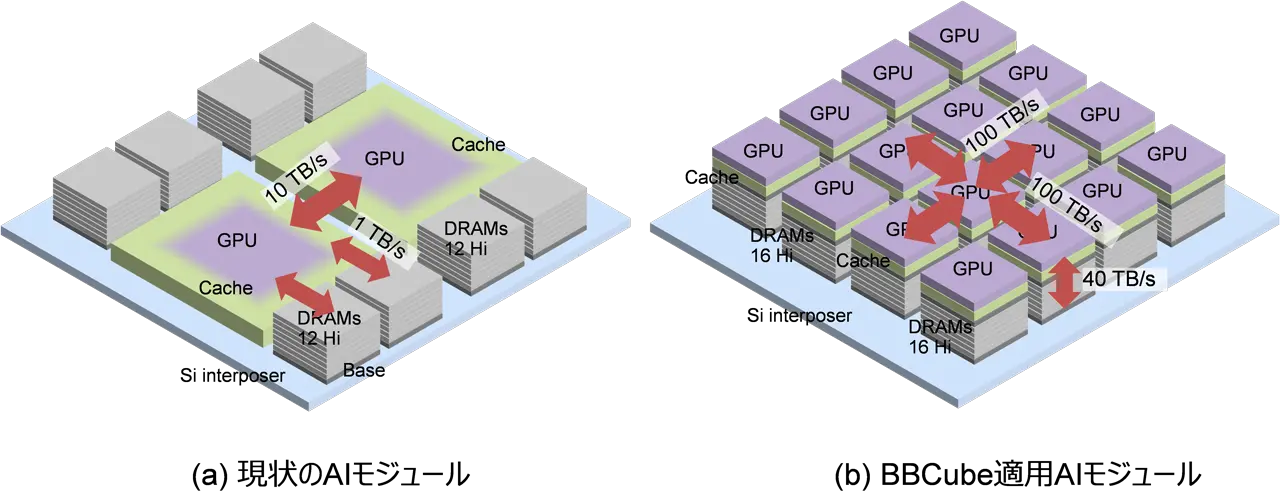2025-05-29 理化学研究所,東京理科大学,京都大学,千葉大学,広島大学

図3 NinjaSatが観測したSRGA J1444のX線強度変化
<関連情報>
- https://www.riken.jp/press/2025/20250529_2/index.html
- https://academic.oup.com/pasj/advance-article/doi/10.1093/pasj/psaf014/8130732
- https://academic.oup.com/pasj/advance-article/doi/10.1093/pasj/psaf003/8130729
- https://academic.oup.com/pasj/advance-article/doi/10.1093/pasj/psae117/8130731
ニンジャサット:天文X線キューブサット観測所 NinjaSat: Astronomical X-ray CubeSat observatory
Toru Tamagawa , Teruaki Enoto , Takao Kitaguchi , Wataru Iwakiri , Yo Kato , Masaki Numazawa , Tatehiro Mihara , Tomoshi Takeda , Naoyuki Ota , Sota Watanabe …
Publications of the Astronomical Society of Japan Published:14 May 2025
DOI:https://doi.org/10.1093/pasj/psaf014
Abstract
NinjaSat is an X-ray CubeSat designed for agile, long-term continuous observations of bright X-ray sources, with the size of 6U (112.7×237.1×340.5 mm3) and a mass of 8 kg. NinjaSat is capable of pointing at X-ray sources with an accuracy of less than 0∘.1 (2σ confidence level) with three-axis attitude control. The satellite bus is a commercially available NanoAvionics M6P, equipped with two non-imaging gas X-ray detectors covering an energy range of 2–50 keV. A total effective area of 32 cm2 at 6 keV is capable of observing X-ray sources with a flux of approximately 10−10 erg cm−2 s−1. The arrival time of each photon can be tagged with a time resolution of 61μs. The two radiation belt monitors continuously measure the fluxes of protons above 5 MeV and electrons above 200 keV trapped in the geomagnetic field, alerting the X-ray detectors when the flux exceeds a threshold. The NinjaSat project started in 2020. Fabrication of the scientific payloads was completed in 2022 August, and satellite integration and tests were completed in 2023 July. NinjaSat was launched into a Sun-synchronous polar orbit at an altitude of about 530 km on 2023 November 11 by the SpaceX Transporter-9 mission. After about three months of satellite commissioning and payload verification, we observed the Crab Nebula on 2024 February 9 and successfully detected the 33.8262 ms pulsation from the neutron star. With this observation, NinjaSat met the minimum success criterion and stepped forward to scientific observations as initially planned. By the end of 2024 November, we successfully observed 21 X-ray sources using NinjaSat. This achievement demonstrates that, with careful target selection, we can conduct scientific observations effectively using CubeSats, contributing to time-domain astronomy.
ニンジャサットによるクロックド・バースターSRGA J144459.2-604207からのI型X線バーストの観測 NinjaSat monitoring of Type I X-ray bursts from the clocked burster SRGA J144459.2–604207
Tomoshi Takeda , Toru Tamagawa , Teruaki Enoto , Takao Kitaguchi , Yo Kato , Tatehiro Mihara , Wataru Iwakiri , Masaki Numazawa , Naoyuki Ota , Sota Watanabe …
Publications of the Astronomical Society of Japan Published:14 May 2025
DOI:https://doi.org/10.1093/pasj/psaf003
Abstract
The CubeSat X-ray observatory NinjaSat was launched on 2023 November 11 and has provided opportunities for agile and flexible monitoring of bright X-ray sources. On 2024 February 23, the NinjaSat team started long-term observation of the new X-ray source SRGA J144459.2–604207 as the first scientific target, which was discovered on 2024 February 21 and recognized as the sixth clocked X-ray burster. Our 25-day observation covered almost the entire decay of this outburst from two days after the peak at ∼100mCrab on February 23 until March 18 at a few mCrab level. The Gas Multiplier Counter on board NinjaSat successfully detected 12 Type I X-ray bursts with a typical burst duration of ∼20s, shorter than other clocked burster systems. As the persistent X-ray emission declined by a factor of five, X-ray bursts showed a notable change in its morphology: the rise time became shorter from 4.4(7)s to 0.3(3)s (1σ errors), and the peak amplitude increased by 44%. The burst recurrence time Δtrec also became longer, from 2 to 10hr, following the relation of Δtrec∝F−0.84per, where Fper is the persistent X-ray flux, by applying a Markov chain Monte Carlo method. The short duration of bursts is explained by the He-enhanced composition of accretion matter and the relation between Δtrec and Fper by a massive neutron star. This study demonstrated that CubeSat pointing observations can provide valuable astronomical X-ray data.
クロックドX線バースターSRGA J144459.2-604207の非太陽元素組成の証拠 Evidence of non-solar elemental composition in the clocked X-ray burster SRGA J144459.2-604207
Akira Dohi , Nobuya Nishimura , Ryosuke Hirai , Tomoshi Takeda , Wataru Iwakiri , Toru Tamagawa , Amira Aoyama , Teruaki Enoto , Satoko Iwata , Yo Kato …
Publications of the Astronomical Society of Japan Published:14 May 2025
DOI:https://doi.org/10.1093/pasj/psae117
Abstract
In 2024 February and March, a series of many Type I X-ray bursts were observed from the accreting neutron star SRGA J144459.2-604207, which has been identified by multiple X-ray satellites, with the first reports coming from INTEGRAL and NinjaSat. These observations reveal that after exhibiting very regular behavior as a “clocked” burster, the peak luminosity of the SRGA J144459.2-604207 X-ray bursts shows a gradual decline. The observed light curves exhibit a short plateau feature, potentially with a double peak, followed by a rapid decay in the tail-features unlike those seen in previously observed clocked bursters. In this study, we calculate a series of multizone X-ray burst models with various compositions of accreted matter, specifically varying the mass fractions of hydrogen (X), helium (Y), and heavier CNO elements or metallicity (ZCNO). We demonstrate that a model with higher ZCNO and/or lower X/Y compared to the solar values can reproduce the observed behavior of SRGA J144459.2-604207. Therefore, we propose that this new X-ray burster is likely the first clocked burster with non-solar elemental compositions. Moreover, based on the X-ray burst light curve morphology in the decline phase observed by NinjaSat, a He-enhanced model with X/Y≈1.5 seems preferred over high-metallicity cases. We also give a brief discussion on the implications for the neutron star mass, binary star evolution, inclination angle, and the potential for a high-metallicity scenario, the last of which is closely related to the properties of the hot CNO cycle.



